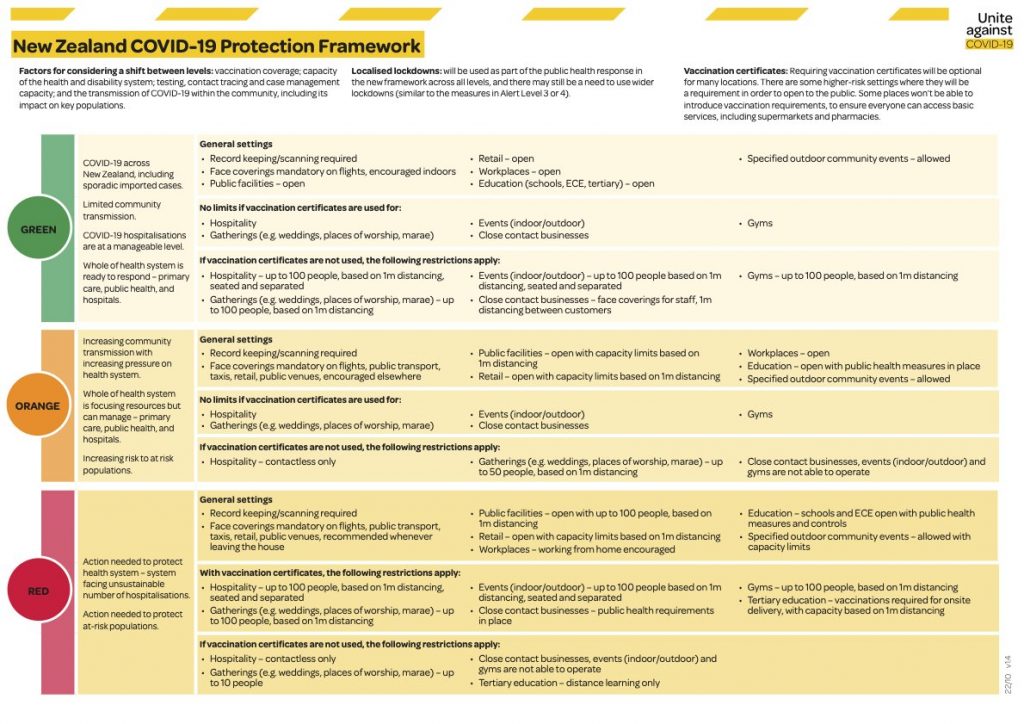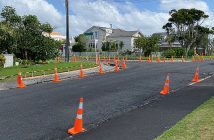Covid Alert Levels will soon be a thing of the past, but is the new traffic light system much better and will it still keep a lid on the virus?

Red, Orange and Green will take the place of the Alert Level system, with Red having the highest restrictions and Green having the least. The new system is due to kick in once every DHB across New Zealand reaches a 90% vaccination rate.
Prime Minister Jacinda Ardern admits that the new system is similar to the current Alert Level system, but says there are key differences:
- Vaccine certificates: Businesses can operate in Red, Orange or Green settings, but anyone without a vaccine certificate will face restrictions.
- Lockdowns: Rather than implementing nationwide lockdowns, highly targeted and more localised lockdowns may be used, particularly in areas with lower vaccination rates.
The new system also seems to be more focussed on the capacity of our healthcare system rather than on raw case numbers.
“The traffic light system gives some certainty to retail and hospitality, as well as to organisations generally about how business will operate while Delta is circulating,” says the University of Otago’s Dr Paula O’Kane.
However she is worried that across all three levels, it still leaves the hospitality and events sector being asked to decide whether to ‘police’ vaccination on their premises.
“This is a potentially difficult situation, with staff being left open to customer criticism and/or abuse. The government should consider mandating certificates instead, taking the controversial decision away from already over stretched small businesses.
“It also doesn’t answer the question about whether staff are included in the vaccination mandate – can an unvaccinated member of staff serve in a premises operating a vaccination certificate check?”
O’Kane says it is now critical that workplaces ensure that their working from home polices are updated or in place for contingences across all three levels.
“They must provide their employees which adequate equipment, software, hardware and internet access, to do their job safely, and that they plan for how to communicate effectively with their staff.
“Health, safety, and wellbeing are integral, particularly mental health and wellbeing, which we know has suffered through these latest lockdowns.”
The University of Otago’s Dr Amanda Kvalsvig says there is a very strong emphasis on vaccination, but putting all our eggs in one basket comes with several risks:
- Children under 12 are not yet eligible to be vaccinated and the trial data on 5-11 year-olds hasn’t been seen and scrutinised. While we hope the vaccines will be safe and effective for young children, we can’t yet make that assumption.
- Although Māori are rapidly catching up with other population groups, a 90 per cent DHB target could leave many Māori still only partially vaccinated when restrictions are lifted.
- Building a pandemic response around vaccines means that the plan may very quickly go out of date. Population protection from vaccines is likely to change over the next few months. A third Pfizer vaccine dose will probably be required to maintain immunity, and new variants could make current vaccines less effective.
- In the new settings, effective measures to limit airborne spread of the virus don’t appear to be calibrated to risk levels. This means that when there’s active community tranmission there’s very little protection in public spaces for those who aren’t vaccinated, particularly children.
“Effective measures include optimising indoor ventilation in schools, workplaces, shops, and entertainment venues; supporting mask use; providing paid sick leave for all workers, and many more,” Kvalsvig says.
“Without these public health and social measures hardwired into the system, we may be vulnerable in future to new Covid-19 variants and to other respiratory infections that are waiting to make a comeback once border restrictions are relaxed.”
Kvalsvig is concerned that the current plan will increase health inequities and that it hasn’t been explicitly designed to uphold Te Tiriti o Waitangi.
“It’s concerning that the plan doesn’t seem to look further ahead than the next few weeks: we don’t know when the next variant will be along.”
The University of Otago’s Lesley Grey says vaccination as a strategy is hugely important, however it is not the only strategy and in itself for Covid-19 we need to look beyond first and second doses to sustain levels of protection.
“When we look to other countries who have highly vaccinated populations that are still experiencing high case numbers, hospitalisations and deaths (e.g. UK) this signals some levels of acceptability or ‘collateral damage’.”
The University of Auckland’s Dr Rhys Jones is worried that Māori and Pacific communities will be the collateral damage.
“Essentially the government has rolled out a vaccine programme that systematically privileged non-Māori, non-Pacific populations, and then used vaccine coverage predominantly among those populations as the basis for easing restrictions,” Jones says.
“Not only have Māori in particular been neglected in the vaccine rollout, our communities may now be exposed to extremely high risk due to the failures in that rollout.
“It is unethical to significantly ease restrictions any further while vaccine coverage for Māori and Pacific remains dangerously low. Māori and Pacific populations are at much higher risk of serious outcomes from Covid-19 than other ethnic groups, so it is essential that we get vaccine rates up as high as possible.
“The requirement for high coverage is even more important for Māori and Pacific communities – because of our younger populations, approximately 25 per cent are currently ineligible to receive the Covid vaccine. That means we must ensure coverage is as close to 100 per cent as possible among those who are eligible, in order to provide adequate protection for those who are too young to be vaccinated.
“The announcement of additional funding to boost Māori vaccination rates is welcome, however this investment is too little, too late. This should have been the singular priority from day one.
“Māori should have been at the centre of the Covid-19 vaccine programme, and should have been leading the programme, the whole way through.”







